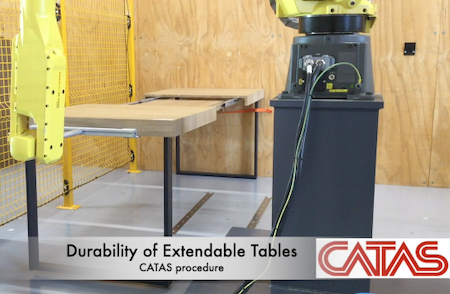
In the production of
tables, especially for domestic use, a solution adopted to a large extent is that of allowing the surface area of the top to be increased by means of
extensions that can be positioned after the main top has been slid.
In the various reference standards for testing the strength and durability of tables, there are some tests for this type of table as well, but they do not include a test to evaluate the durability of the sliding system.
Especially in the case where this sliding system consists of ball-bearing slides and pulley systems with steel cables, an
endurance test to ensure that the system does not malfunction over time can be useful.
For this purpose, we have set up an internal test procedure that involves moving the table by means of an
anthropomorphic arm, lifting and moving it simulating real use. The set speed is 250 mm/s, taking the value from the durability test of drawer slides according to EN 16122.
Usually, the opening of this type of table is not carried out very frequently, considering a "normal" use of one opening per day, we have set
a minimum number of 2,000 cycles for the test (one cycle means a complete opening and closing of the table), which can be considered sufficient to guarantee a service life of several years. This number of cycles is also indicated in EN 16121 for the durability test of furniture with castors, where intensive use is not expected, such as the opening of a drawer or door.
Clearly, the concept of "normal" in the use of a piece of furniture can be subject to an infinite number of interpretations,
the number of cycles, therefore, can be defined on a case-by-case basis depending on the particularity of the table to be tested and the manufacturer's requirements.
For info:Maurizio Marussi
+39 0432 747225
marussi@catas.com

 In the production of tables, especially for domestic use, a solution adopted to a large extent is that of allowing the surface area of the top to be increased by means of extensions that can be positioned after the main top has been slid.
In the production of tables, especially for domestic use, a solution adopted to a large extent is that of allowing the surface area of the top to be increased by means of extensions that can be positioned after the main top has been slid.